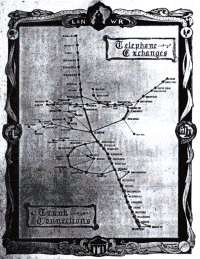
Sam Hallas' Website
 The map shows the extent of the
L&NWR's network in 1915. Starting at Euston it follows the present West
Coast Main Line to Crewe. The loop to the West takes in Coventry, Birmingham
and Wolverhampton. From Crewe it branches off to the West to Holyhead, and to
the East to Stockport and Leeds with a return via Manchester. Beyond Crewe the
line continues via Preston and Lancaster as far as Carlisle. I'm sorrythe
present map is only a photocopy. I hope I can get it scanned it at better
resolution in the future.
The map shows the extent of the
L&NWR's network in 1915. Starting at Euston it follows the present West
Coast Main Line to Crewe. The loop to the West takes in Coventry, Birmingham
and Wolverhampton. From Crewe it branches off to the West to Holyhead, and to
the East to Stockport and Leeds with a return via Manchester. Beyond Crewe the
line continues via Preston and Lancaster as far as Carlisle. I'm sorrythe
present map is only a photocopy. I hope I can get it scanned it at better
resolution in the future.
Please look up number before calling an exchange.
Speak close to the mouthpiece, quietly and distinctly. Do not shout.
Replace receiver when conversation is finished, but not before.
Unless the receiver is on the hook you cannot be called.
When a call is put through to a wrong number, the caller must move the hook slowly up and down to obtain the attention of the exchange operator. When the operator answers transfer the call to the correct number. If the hook is not moved slowly the operator does not get the signal. When a trunk call is put through to a wrong number the operator should be informed at once by the person called by making use of the following phrase : "Trunk call in error."
Inter-communication (one extension to another on the same exchange) can be obtained by giving the number required only. If another exchange is required, the name of the exchange must be given first, followed by the number, thus : "Rugby, two, eight."
Promptitude in answering and brevity in speaking are the essence of a successful telephone service.
THE TELEPHONE IS RESERVED FOR THE COMPANY'S BUSINESS.
On the Companys trunk lines conversation is limited to a period of six minutes counted from the time the operator notifies that the connection is completed. Although the limit of six minutes has been laid down, it is considered that the time limit of three minutes which is enforced on the public trunk lines is in most instances ample, and it is specially requested that anyone making a trunk call on the Railway lines will be as prompt as possible so that every advantage can be obtained from the service.
It is desired that the greatest courtesy should be exercised when speaking on the telephone. When concluding a conversation on the telephone notify the caller at the other end that you have-finished.
ALL TELEPHONE FAULTS SHOULD BE PROMPTLY REPORTED TO THE
TELEPHONE EXCHANGE OPERATOR WHO WILL INFORM THE ELECTRICAL INSPECTOR AND
LINEMAN.
L. W. HORNE,
Superintendent of the Line.
EUSTON STATION LONDON,
August, 1915.
I felt the alphabetical list of places with the various extensions was of limited interest, so I've spared you that. However, it is worth noting that the instructions for use above suggest that CB working was the norm on the L&NWR. Compare this with the GNR, where it appears that magneto working was still in use.
Line plant was evidently in short supply in some places as several sites have party line working. For instance:
| Morecambe | Booking Office | Lancaster 17 (1 ring) |
| Morecambe | Loco Hut | Lancaster 17 (2 rings) |
and
| Manchester (Oxford Road) | Booking Office | Ordsall Lane 8 (2 rings) |
| Manchester (Oxford Road) | Secretary's Office | Ordsall lane 8 (3 rings) |
At Birkenhead, where the lines of the two Railway companies met, the L&NWR exchange served some Great Western locations in addition to its own, and several joint locations.
You may now continue to the Great Northern Railway Directory